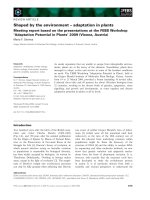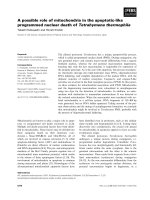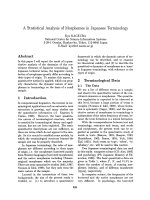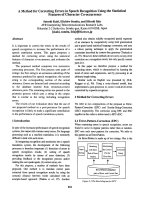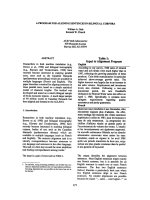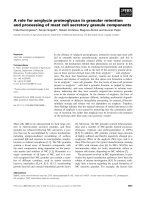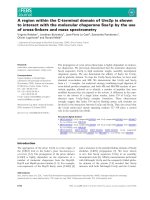báo cáo khoa học: " A cluster randomised controlled trial in primary dental care based intervention to improve professional performance on routine oral examinations and the management of asymptomatic impacted third molars: study protocol" pptx
Bạn đang xem bản rút gọn của tài liệu. Xem và tải ngay bản đầy đủ của tài liệu tại đây (281.31 KB, 9 trang )
BioMed Central
Page 1 of 9
(page number not for citation purposes)
Implementation Science
Open Access
Study protocol
A cluster randomised controlled trial in primary dental care based
intervention to improve professional performance on routine oral
examinations and the management of asymptomatic impacted
third molars: study protocol
Theodorus G Mettes*
1
, Wil JM van der Sanden
1
, Michel Wensing
2
,
Richard PTM Grol
2
and Alphons JM Plasschaert
1
Address:
1
Radboud University Nijmegen Medical Centre, Department of Preventive and Restorative Dentistry, College of Oral Sciences, Nijmegen,
The Netherlands and
2
Radboud University Nijmegen Medical Centre, Centre for Quality-of-care Research (WOK), Nijmegen, The Netherlands
Email: Theodorus G Mettes* - ; Wil JM van der Sanden - ;
Michel Wensing - ; Richard PTM Grol - ;
Alphons JM Plasschaert -
* Corresponding author
Abstract
Background: Routine oral examination (ROE) refers to periodic monitoring of the general and oral
health status of patients. In most developed Western countries a decreasing prevalence of oral diseases
underpins the need for a more individualised approach in assigning individualised recall intervals for regular
attendees instead of systematic fixed intervals. From a quality-of-care perspective, the effectiveness of the
widespread prophylactic removal of mandibular impacted asymptomatic third molars (MIM) in adolescents
and adults is also questionable. Data on the effectiveness of appropriate interventions to tackle such
problems, and for promoting continuing professional development in oral health care are rare.
Methods/design: This study is a cluster randomised controlled trial with groups of GDPs as the unit of
randomisation. The aim is to determine the effectiveness and efficiency of small group quality improvement
on professional decision-making of general dental practitioners (GDPs) in daily practice. Six peer groups
('IQual-groups') shall be randomised either to the intervention arm I or arm II. Groups of GDPs allocated
to either of these arms act as each other's control group. An IQual peer group consists of eight to ten
GDPs who meet in monthly structured sessions scheduled for discussion on practice-related topics. GDPs
in both trial arms receive recently developed evidence-based clinical practice guidelines (CPG) on ROE or
MIM. The implementation strategy consists of one interactive IQual group meeting of two to three hours.
In addition, both groups of GDPs receive feedback on personal and group characteristics, and are invited
to make use of web-based patient risk vignettes for further individual training on risk assessment policy.
Reminders (flow charts) will be sent by mail several weeks after the meeting.
The main outcome measure for the ROE intervention arm is the use and appropriateness of individualised
risk assessment in assigning recall intervals, and for the MIM-intervention group the use and
appropriateness of individualised mandibular impacted third molar risk management. Both groups act as
each other's control. Pre-intervention data will be collected in study months one through three. Post-
intervention data collection will be performed after nine months.
Published: 20 April 2007
Implementation Science 2007, 2:12 doi:10.1186/1748-5908-2-12
Received: 4 August 2006
Accepted: 20 April 2007
This article is available from: />© 2007 Mettes et al; licensee BioMed Central Ltd.
This is an Open Access article distributed under the terms of the Creative Commons Attribution License ( />),
which permits unrestricted use, distribution, and reproduction in any medium, provided the original work is properly cited.
Implementation Science 2007, 2:12 />Page 2 of 9
(page number not for citation purposes)
Background
Routine oral examination (ROE) refers to periodic moni-
toring of the general and oral health status of patients. The
main purpose of ROEs is to prevent the onset of oral dis-
eases and/or prevent further progression. This allows the
introduction of preventive interventions at the appropri-
ate time, and reduces the need for operative interventions.
In most developed Western countries, a decreasing preva-
lence of oral diseases underpins the need for a more indi-
vidualised approach in assigning individualised recall
intervals for regular attendees instead of systematic deci-
sion-making of fixed intervals. In The Netherlands, about
80% of the population regularly visits the dentist for a
check-up about every six months [1]. This implies that
many healthy individuals are scheduled for routine oral
screening. In 2000, 50% of the Dutch GDPs assigned all
their regular patients for ROE twice a year [2], irrespective
of level of risk for oral disease. The efficiency of this sys-
tematic monitoring system is still disputed in The Nether-
lands, as well as internationally [3-10]. Recently, two
systematic reviews [11,12] and a clinical practice guide-
line (CPG) advocated an individualised risk-based assess-
ment strategy, given the lack of good scientific evidence
[13]. In addition to the debate over the frequency of ROE,
GDPs also question from a quality-of-care perspective the
effectiveness of the widespread prophylactic removal of
mandibular impacted asymptomatic third molars (MIM)
in adolescents and adults [14-16].
Recent implementation studies in medical care indicate
that evidence on the effect of single interventions is mixed
[18,19]. It is as yet unclear how quality of oral care in den-
tal practice can be improved. Research data on effective-
ness of interventions to promote continuing professional
development for dentists are rare [17]. A previous study
showed that small group education sessions did not
change dentists' clinical behaviour [20]. The aim of the
present study is to evaluate whether a multifaceted strat-
egy can enhance oral health care according to evidence-
based dental practice. Consensus-based CPGs on ROEs
[13] and on the management of MIMs [20] are available
for educational purposes in clinical practice.
Aim of the study
To determine the effectiveness and efficiency of small
group quality improvement on professional decision-
making of general dental practitioners (GDPs) concerning
risk assessment in ROEs (including assigned recall inter-
vals) and risk management of MIMs for patients (children
and adults) in dental practice.
Scientific hypothesis
Multifaceted implementation of consensus-based clinical
practice guidelines (CPGs) for GDPs on ROEs and the
management of MIMs in daily dental practice is more
effective and efficient compared to dissemination of CPGs
only.
Methods
Study design
The study is a cluster-randomised trial with incomplete
block design. In one trial arm, the intervention focuses on
individual decision-making in scheduling ROEs. In the
second arm, the intervention focuses on monitoring and
decision-making regarding prophylactic removal versus
retention of MIM. Groups of GDPs allocated to either of
these arms act as each other's control group. To reduce
potential contamination, groups of GDPs are randomised
rather than individual GDPs (Table 1). We assumed that
the two clinical conditions (or practices) were largely
independent of one another, i.e. performing one would
not necessarily influence the other. In the ROE arm, the
CPG only mentions the necessity of third molars screen-
ing in general as routine oral care. In the MIM arm, the
CPG provides an extensive, but specific, decision-making
algorithm, i.e. how to deal with mandibular asympto-
matic impacted third molars.
Recruitment of GDPs and inclusion/exclusion criteria
Dental peer groups ("IQual-group"), each comprising at
least eight participating GDPs, are the unit of randomisa-
tion. An IQual group consists of GDPs who attend
monthly sessions scheduled for discussion on practice-
related topics as part of a quality assurance program. Par-
ticipants in peer groups generally support quality-
improvement procedures, and are experienced in contin-
uing dental education and professional cooperation. The
Dutch Dental Association (NMT) has initiated this sys-
Table 1: Balanced incomplete block design
Intervention CPG
ROE MIM
Group I (ROE) Intervention Control
Group II (MIM) Control Intervention
Intervention: Clinical Practice Guideline (CPG) on the management of routine oral examinations (ROE) and asymptomatic mandibular impacted
third molars (MIM).
Implementation Science 2007, 2:12 />Page 3 of 9
(page number not for citation purposes)
tem, and supports nationwide dental peer groups exten-
sively, e.g., offering professional support, feedback and
continuing education programmes. All IQual-groups were
invited to participate in this study by a general announce-
ment on the NMT website, dependent on their ability to
begin the study within two to three months. Those groups
that were interested in participating were invited to visit a
section of the NMT website
for mem-
bers only that provided more detailed information on the
project.
GDP inclusion criteria
The inclusion criteria consisted of:
• GDPs who work for at least for three days a week in gen-
eral dental practice for a minimum of three years
• GDPs who have a patient population of regular ROE-
attendees and manage their patient records electronically.
• GDPs were required to give their informed consent for
the assessment and evaluation of electronic patient
records. Patient data are collected anonymously.
Patient's inclusion criteria
To be eligible for inclusion in the study, all patients must
have regularly visited the same dentist at least once a year
for ROEs over the preceding three years. For the MIM arm,
patients should also be between 17 and 35 years of age,
and with disease-free impacted mandibular third molars
in retention.
Patient's exclusion criteria
For the ROE arm, patients with symptomatic-driven
(emergency) attendance in dental practice, or regular
attendance in the participating dental practice of less than
three years, are excluded from the study. For the MIM arm,
patients with symptomatic or previously removed third
molars, or regular attendance in the participating dental
practice of less than three years, are excluded from the
study
Intervention
Implementation strategy
Participants in both trial arms receive a recently developed
evidence-based CPG on ROE or MIM. The implementa-
tion strategy consists of one interactive IQual group meet-
ing of approximately two to three hours with a minimum
of eight GDPs each. These meetings discuss the selected
intervention topic, and offer a more risk-based decision-
making process guided by the CPG. Topics regarding risk
management, such as identification of risk factors/indica-
tors, preventive interventions, prognosis, monitoring,
record keeping, and patient scheduling are presented. In
addition, all participants receive feedback from personal
and group characteristics retrieved from pre-test question-
naire and specific record forms, and are invited to make
use of web-based patient risk vignettes for further individ-
ual training on risk assessment policy. These risk vignettes
were developed by structured consensus procedures
(modified Delphi) with expert groups consisted of
acknowledged GDPs and oral surgeons in special fields. In
addition, reminders (flow charts) and written patient leaf-
lets with topical information are provided during the trial
period. Flow charts comprise algorithms of decision-mak-
ing aspects linked to the trial arm allocation. Depending
on the allocated trial arm, participants are subjected to a
set of planned interventions as described in Table 2.
Randomisation
After their commitment to participate, 60 GDPs nested in
six IQual groups were randomly assigned (using SPSS) as
Table 2: Overview of planned interventions in groups I and II.
Interventions for all IQualgroups
Composition IQual group Introductory letter
(individual) Delivery registration forms and
questionnaires
Questionnaire GDPs 25 observations chair side
Randomisation
Interventions trial arms ROE group I MIM group II
Delivery CPG on ROE versus MIM by post CPG ROE CPG MIM
Education session IQual group ROE education MIM education
Online training website (individual feed back) Access to ROE-based training Access to MIM-based training
Reminder (flow chart), individual feed back
record form Feed back by email
ROE- aspects Flow chart MIM-aspects Flow chart
Registration in practice (25) 25 observations in practice chair side 25 observations in practice chair side
End trial Questionnaire Questionnaire
Implementation Science 2007, 2:12 />Page 4 of 9
(page number not for citation purposes)
groups to the ROE or MIM arm by an independent secre-
tary not familiar with the groups. The unit of randomisa-
tion was the IQUAL group.
Outcomes and instruments
ROE study
Table 3 lists the outcome parameters and instruments
used. For the ROE arm, the primary outcome measure is
the use and appropriateness of individualised risk assess-
ment measured through the assigned recall intervals (in
months). The appropriateness will be assessed as follows:
• For high-risk children and adolescents (0 to 18 years),
recall intervals of less or equal than seven months should
be assigned. For those with a low-risk profile, an assigned
recall of more than seven months is considered appropri-
ate.
• For high-risk adults (18 years and older): recall intervals
of less than nine months should be assigned. For those
with a low-risk profile, an interval of nine months or
longer is considered appropriate.
The secondary outcome measures for the ROE arm are:
1. The use and appropriateness of individualised risk-
based assessment in prescribing bitewing radiographs
(BWs) in months. The appropriateness will be assessed as
follows:
• For high caries-risk children and adolescents (0 to 18
years): BW frequencies of less than 24 months are deter-
mined as appropriate; for those with a low-caries risk pro-
file, BW frequencies equal or more than 36 months.
• For high caries risk adults (18 years and older): BW fre-
quencies less than 36 months are determined as appropri-
ate; for those with a low-caries risk profile, BW frequencies
of equal or more than 48 months.
Table 3: Outcome parameters and instruments
Outcome parameter Instruments
Primary ROE-outcomes Clinical Performance/decision-making:
Number of patients per GDP with assigned recall interval
(months) based on individual risk profile assessment. For high-
risk children and adolescents' intervals less than seven months, in
case of low risk profile more than seven months; for low-risk
adults' profiles, nine months equal or more, and for high-risk
adults' profiles less than nine months.
Patient record, registration form, to
analyse risk management
Secondary ROE-outcomes Clinical Performance/decision-making:
Number of patients per GDP with prescribed individual
frequency of BWs (months). For high-risk children and
adolescents, frequencies of less than 24 months, and for low-risk
profiles, frequencies of more than 36 months; for high-risk
adults, prescription frequencies less than 36 months, and for low
risk adults, prescription of more than 48 months. Number of
patients per GDP with periodontal DPSI-score > 1, and
prevalent caries, who have been given feedback, information and
preventive advice, registered in patient record or registration
form.
Efficacy data/cost-effectiveness scores:
Mean overall length in months of recall intervals per GDP over
the past 3 yrs Mean total number of BW(s) and other
radiographs over past 3 years
Type of performer GDP/Oral hygienist/others (level of
graduation, education)
Total number of additional interventions performed during ROE
(polishing, removal of calculus: coded as M50, M55).
Professional attitudes and compliance:
Measured at the beginning and end of the trial, by questionnaire.
Patient record, registration form,
questionnaire to analyse additional
performance and cost-analysis
Primary MIM-outcome Clinical performance/decision-making:
Number of patients (between 17 -35 yr of age) with removed
versus retained MIMs in accordance with CPG, or with
indication for removal.
Number of risk-based assessment radiographs between 17– 35-
yrs/per patient with risk-based for assessment of prognosis MIM.
Patient record, registration form to
analyse risk management
Secondary MIM-outcome Professional attitudes/compliance and feedback:
Interviews of patients (17–35 years of age) to confirm risk-based
performance.
Questionnaire
Implementation Science 2007, 2:12 />Page 5 of 9
(page number not for citation purposes)
2. The use and appropriateness of individualised commu-
nication/feedback and advice in patients with a periodon-
tal risk DPSI-score >1, and present dental caries
experience. The appropriateness will be assessed as the
proportion of patients per GDP receiving appropriate pre-
ventive advice/feedback will be calculated. Furthermore,
as a secondary outcome measure, professional role per-
ceptions and compliance concerning the recommenda-
tions of the ROE-CPG is assessed by means of
questionnaires provided at the beginning and end of the
study.
3. Resource use will be documented for an economic eval-
uation:
• The type of recall interval (months) per GDP over the
past 3 years
• BW radiographs and other types of radiographs per GDP
over the past 3 years
• Type of performer of ROEs: GDP versus oral hygienist/
dental auxiliary
• Additional interventions per GDP (i.e. polishing stains/
removing dental calculus) encompassed at ROEs over the
past 3 years.
MIM study
For the MIM arm, the primary outcome is the use and
appropriateness of individualised MIM risk management.
The appropriateness will be assessed as follows:
• Patients (17–35 years of age) with removed versus
retained MIMs over the past five years as a proportion of
patients aged between 17–35 years of age per practice
• Radiographs used for monitoring patients mentioned
above to perform a risk-based assessment and prognosis
of MIM over the past five years.
A secondary outcome measure is GDPs- attitudes and
compliance concerning the recommendations of the
MIM-CPG, and relating that information to patients. This
measure will use data from patient interviews to confirm
risk-based performance.
All data will be collected using special registration forms
to be completed by GDPs and patient records available in
practices. Questionnaires, patients' records, and registra-
tion forms will provide information to assess all outcome
parameters. The structured registration forms were used in
a previous self-recording study [23].
Data collection
After their informed consent to participate, GDPs will be
invited to first complete a questionnaire to collect per-
sonal and practice characteristics, as well as aspects of atti-
tude and compliance. Individual assessment of electronic
patient records with regard to the outcome measures,
combined with a special registration form (to be applied
individually in daily practice), will be used during the
evaluation period.
Baseline information will be collected before randomisa-
tion of groups, as well as at the end of the trial after seven
to nine months. Each GDP will be instructed to complete
at least 20 forms per registration period. As each peer
group consists of at least eight participants, and each arm
will consist of three groups, this will result in a minimum
of 480 registrations per trial arm. Finally, questionnaires
will be collected from GDPs, dentist's assistants and co-
workers to assess acceptance and applicability.
Sample size
The primary outcome measures in this study are collected
from individual patients who are clustered within GDPs.
GDPs are clustered within (existing) IQual groups which
have been randomised to one of the two arms of the trial.
The power calculation assumes that the primary outcomes
are dichotomous measures, although some outcomes
might be treated as continuous measures as well. On the
basis of previous research and experience with IQual
groups, we expect a relatively high clustering of scores
within GDPs, for instance, the intra-cluster coefficient
(ICC) for recall interval assignment was 0.29 [23], and a
low clustering of scores within IQUAL groups (changing
professional behaviour is largely determined by other fac-
tors). We use the ICC for clustering in IQual groups,
because this was the unit of randomisation. We aim for a
20% change on primary outcomes (e.g. 20 to 40%
patients receive individualised recall intervals). Assuming
a power of 80%, alpha = 0.05 and an effect size of 20% for
both interventions and an estimated ICC of 0.03 based on
previous estimates [21,22], the (Aberdeen) power calcula-
tion [24] revealed that six IQual groups (60 GDPs) should
comprise 150 registrations (patients) per group, resulting
in at least 450 registrations in each trial arm.
Statistical analysis
The primary analysis will be performed on an intention-
to-treat-analysis. Secondly, measures will be constructed
in particular algorithms to define the appropriateness in
variables. Thirdly, the impact on each of the primary and
secondary outcomes will be estimated separately, using
random effects regression models (linear or logistic) to
take into account the clustering of data. These basic mod-
els include group allocation (intervention, control),
measurement timing (baseline, post-intervention), and
Implementation Science 2007, 2:12 />Page 6 of 9
(page number not for citation purposes)
interaction of group allocation and measurement timing
(=intervention effect). Fourthly, prognostic factors for the
outcome (which may be confounders) will be added to
the models, like patients' recall interval preferences, which
varies from those assigned by GDPs, as well as the prefer-
ences regarding the prescription of radiographs by
patients/GDPs. In addition, this also accounts for GDPs
and patients' preferences regarding removal versus reten-
tion of asymptomatic impacted third molars. Fifthly, a
limited number of subgroup analyses will be performed,
including an analysis of effectiveness in participants
which performed all activities as planned, i.e., education
session, online training program, and helpdesk (= efficacy
analysis).
Economic evaluation
An economic evaluation is performed to estimate the cost-
effectiveness of the implementation intervention. This
study takes a healthcare perspective and a time horizon
that is similar to the implementation trial.
Effectiveness
The effects are defined in terms of professional perform-
ance, because measuring health outcomes or health utili-
ties is beyond the scope of the study. Outcome measures
will be the same as in the trial (e.g. oral health risks assess-
ment performance and guideline adherence regarding
individual recall assignment and individual monitoring
of impacted asymptomatic third molars) and extracted
from the trial data.
Costs
Costs considered are those used for the implementation
(time for participation by GDPs, preparation time, use of
materials) and for changes (if any) in professional per-
formance (recall intervals between successive ROEs, total
number of radiographs, both based on individual risk
assessment). Oral care unrelated to the topic of the inter-
ventions within the observed time period will not be con-
sidered. Resource use will be extracted from trial data,
where possible, or collected separately for the purpose of
the economic evaluation. Costs will be valued according
to prevailing Dutch guidelines for economic evaluations,
and alternatively according to the current national fee-
coding list for individual oral treatment procedures in
general dental practice.
Analysis
An incremental cost effectiveness ratio (ICER) will be con-
structed that expresses the ratio of differences of costs and
effects between the study arms (for each of the two clinical
topics). Uncertainty will first be examined in one-way sen-
sitivity analyses of the most influential factors. Finally, a
non-parametric bootstrap re-sampling analysis will be
performed, which provides a cost-effectiveness plane for a
simulated sample of 1,000 drawings (with put-back) from
the pool of observed cost-effect pairs.
These data will be compiled from questionnaires, patient
risk profiles, registration forms, and from electronic
patient records. All instruments were pre-tested in a pilot
study. Measurements and analysis of pre-test data will be
performed before or during the intervention period (for
retrospective data sampling), and after the intervention
period (post-intervention data).
Timeframe of the study
We plan to randomise six of the initially recruited IQual
groups that have declared their willingness to participate
in this study, and to assign them randomly to one of the
two intervention arms. The baseline data collection will
take place at the beginning of the study during months
one and two. The intervention will start in months two
and three, and follow-up data collection will be collected
in months eight through ten. The scheduled time for the
trial is estimated to be seven to ten months (Appendix 1),
assuming that each GDP will collect data from at least 20
regular attending patients by means of the trial registra-
tion form.
Discussion
Little evidence was available on the estimates of the likely
size of dental primary care ICCs, and which prognostic
factors influenced their magnitude. Based on research in
this field, we assumed a substantial variation in primary
dental care between fairly autonomous GDPs [25-28].
Data extracted from primary health care suggested that
ICCs for patient outcomes in primary care were generally
less than 0.05 [21,22]. In reviews of this protocol, ques-
tions were raised about the power calculation. In particu-
lar, the expected effect size was seen as large, and the
applied ICC as low. This would imply that the power cal-
culation is too optimistic, and that the study might be
underpowered to detect meaningful change in profes-
sional behaviour.
Ethical and legal aspects
The study protocol was approved by the Ethics Committee
of the Radboud University Nijmegen Medical Centre,
prior to the start of the study in September 2006 (approval
number CMO nr. 2006/168). All patient data and other
confidential information fall under dental confidentially
rules, and are stored on a protected server of the Radboud
University Nijmegen Medical Centre. Only members of
the study team have access to the files.
Implementation Science 2007, 2:12 />Page 7 of 9
(page number not for citation purposes)
Design timeframe implementation study concerning CPGs on ROE and MIMFigure 1
Design timeframe implementation study concerning CPGs on ROE and MIM.
1
Assessed for eli
g
ibility (n=6)
g
roups
Excluded (n=.):
Not meeting inclusion
criteria (n= ,, reason)
Refused to participate
(n= )
Randomisation
60 GDPs (6 groups)
Intervention
group I
(n=30)
Intervention
group II
(n=29)
Clinical trial
(n= )
Questionnaire
(n=.)
Non response
(n= )
Clinical trial
(n= )
Questionnaire
(n= )
Non response
(n=.)
Analysed
(n= )
Analysed
(n= )
Excluded
(n= ):
Missing data
(n= )
Analysed
(n= )
Analysed
(n= )
Excluded
(n= ):
Missing data
(n= )
Enrollment Allocation Follow u
p
Anal
y
sis
Education session
Online training
Reminder
Individual feed back
Education session
Online training
Reminder
Individual feed back
Questionnaire on practice and personal characteristics of
all respondents and introductory letter
Implementation Science 2007, 2:12 />Page 8 of 9
(page number not for citation purposes)
Authors' contributions
All authors declare that they have no competing interests.
DM, WvdS and MW performed the study and drafted the
manuscript. AP and RG participated in the study design.
All authors have read and approved the final manuscript.
Source of funding
This study is funded by a research grant from The Health
Care Insurance Board (CVZ) in Amsterdam The Nether-
lands.
References
1. van den Berg H, Bruers JJM, van Rossum GMJM, Smits ER, Swinkels
HWAM, Verweij GCG: Tandartsen, tandartsbezoek en tand-
heelkundige zorgverlening in Nederland. Voorburg/Nieuwegein:
CBS/NMT 1998.
2. Mettes TG, Bruers JJ, van der Sanden WJ, Verdonschot EH, Mulder J,
Grol RP, Plasschaert AJ: Routine oral examination: differences
in characteristics of Dutch general dental practitioners
related to type of recall interval. Community Dent Oral Epidemiol
2005, 33:219-26.
3. Benn DK: Extending the dental examination interval: possible
financial and organizational consequences. Evidence-based Den-
tistry 2002, 3:62-63.
4. Helminen SK, Vehkalahti MM: Do check-up intervals correspond
to caries indices in the free public dental service in Helsinki,
Finland. Community Dent Health 2002, 19:166-172.
5. Karkkainen S, Seppa L, Hausen H: Dental check-up intervals and
caries preventive measures received by adolescents in Fin-
land. Community Dent Health 2001, 18:157-161.
6. Lahti SM, Hausen WH, Widström E, Eerola A: Intervals for oral
health examinations among Finnish children and adoles-
cents: recommendations for the future. Int Dent J 2001,
51:57-61.
7. Perlus J: Determining recall frequencies: a controversial issue.
Ontario Dentist 1994, 71(7):31-5.
8. Sheiham A: Is there a scientific basis for six-monthly dental
examinations? Lancet 1977, 2:442-44.
9. Sheiham A, Maizels J, Cushing A, Holmes J: Dental attendance and
dental status. Community Dental Oral Epidemiol 1985, 13:304-09.
10. Kay EJ: How often should we go to the dentist? Br Med J 1999,
319:204-205.
11. Davenport C, Elly K, Salas C, Taylor-Weetman CL, Fry-Smith A,
Bryan S: The clinical effectiveness and cost-effectiveness of
routine dental checks: a systematic review and economic
evaluation. Health Technol Assess 2003,
7(7):.
12. Beirne P, Forgie A, Clarkson JE, Worthington HV: Recall intervals
for oral health in primary care patients. The Cochrane Database
Flow diagram of the progress through different steps of the trialFigure 2
Flow diagram of the progress through different steps of the trial.
1
Figure 2:
Flow diagram of the progress through different steps of the trial
60 General Dental P
r
actitioners
Group
1-3 ROE
Group
4-6 MIM
Pilot:
GDP experience with
CPG on ROE
Start intervention
(Information-
package)
= Assessment (practice):
If appropriate: ROE: Pre test: -3 till 0
months (retrospective); MIM (identical)
ROE, M3: Post test: +7 till +9 months
T
imeframe
(Months)
Instruments
A, B:
patient records, registration forms
Participants: dental peer groups (IQual)
Intervention: identical for both groups, only CPG differs
Sample size: Power = 80%; α
eenzijdig
= 5%; Δ = 20%;
n= 6 groups, ICC: 0.03
Participants
1.
Start pilot
(ca. 10 GDP)
2.
Selection dental
peer groups
(I-Qual)
Outcomes:
1. Documentation /
registered data
2. Risk-based recall interval
3. Frequency radiographs
4. Communication/feed back
5. Risk mana
g
ement MIM
‘
Training
’
+9
+0
-3
Pretest
II
I
+3
PT
Training:
Group and
individual,
(web-site)
Publish with BioMed Central and every
scientist can read your work free of charge
"BioMed Central will be the most significant development for
disseminating the results of biomedical research in our lifetime."
Sir Paul Nurse, Cancer Research UK
Your research papers will be:
available free of charge to the entire biomedical community
peer reviewed and published immediately upon acceptance
cited in PubMed and archived on PubMed Central
yours — you keep the copyright
Submit your manuscript here:
/>BioMedcentral
Implementation Science 2007, 2:12 />Page 9 of 9
(page number not for citation purposes)
Syst Rev 2005. Art. No: CD004346.pub2. DOI: 10.1002/
14651858.CD004346.pub2
13. National Institute of Clinical Excellence (NICE): Dental recall.
Recall intervals between routine dental examinations. Clinical
guideline nr.19. London 2004.
14. Song F, O'Meara S, Wilson P, Golder S, Kleijnen J: The effectiveness
and cost-effectiveness of prophylactic removal of wisdom
teeth. Health Technol Assess 2000, 4(15):1-55. Review
15. Mettes TG, Nienhuijs M, van der Sanden W, Verdonschot E, Plass-
chaert A: Interventions for treating asymptomatic impacted
wisdom teeth in adolescents and adults. Cochrane Database Syst
Rev 2005, 18(2):CD003879.
16. Scottish Intercollegiate Guideline Network: Management of
unerupted and impacted third molar teeth. A national clini-
cal guideline. SIGN publication number 43: Edinburgh 2000.
17. Best HA, Messer LB: Effectiveness of interventions to promote
continuing professional development for dentists. Eur J Dent
Educ 2003, 7(4):147-53.
18. Grol R, Grimshaw J: From best evidence to best practice: effec-
tive implementation of change in patients' care. Lancet
362(9391):1225-30. 2003 Oct 11;Review
19. Grol R, Grimshaw J: Evidence-based implementation of evi-
dence-based medicine. Jt Comm J Qual Improv 1999,
25(10):503-13.
20. van der Sanden WJ, Mettes DG, Plasschaert AJ, Grol RP, Mulder J,
Verdonschot EH: Effectiveness of clinical practice guideline
implementation on lower third molar management in
improving clinical decision-making: a randomized controlled
trial. Eur J Oral Sci 2005, 113(5):349-54.
21. Campbell MK, Mollison J, Grimshaw JM: Cluster trials in imple-
mentation research: estimation of intracluster correlation
coefficients and sample size. Stat Med 20(3):391-9. 2001 Feb 15
22. Campbell M, Grimshaw J, Steen N: Sample size calculations for
cluster randomised trials. Changing Professional Practice in Europe
Group (EU BIOMED II Concerted Action). J Health Serv Res Policy 2000,
5(1):
12-6.
23. Mettes TG, van der Sanden WJM, Mokkink HG, Wensing M, Grol
Richard PTM, Plasschaert Alphons JM: Routine oral examination:
Clinical performance and management by GDPs in primary
oral care. A prospective structured self-recording study.
2006 in press.
24. University of Aberdeen [ />ter.shtml]
25. Bader JD, Shugars DA: Variation, treatment outcomes, and
practice guidelines in dental practice. J Dent Educ 1995,
59(1):61-95. Review
26. Bader JD, Shugars DA: Variation in dentists clinical decisions. J
Public Health Dent 1998, 58:210-219.
27. Poorterman JHG: On quality of dental care; the development,
validation and standardisation of an index for the assessment
of restorative care. Thesis University of Amsterdam: The Nether-
lands; 1997.
28. National Institute of Health 2001: Diagnosis and management of
dental caries throughout life. NIH Consensus statement 2001,
18(1):1-23.

